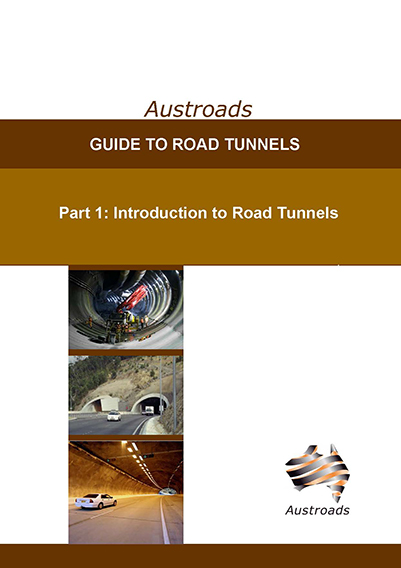Tunnels

Guide to Road Tunnels Part 1: Introduction to Road Tunnels
- Publication no: AGRT01-10
- ISBN: 978-1-921709-27-2
- Published: 1 July 2010
- Superseded
- PDF (free) Download
This Austroads Guide provides a comprehensive introduction to planning for road tunnels and describes important issues and considerations relating to implementation, general planning, regulation, structural and geometric design, drainage, geology, the environment as well as operation, construction and maintenance. It also covers critical considerations such as flood protection, fire and life safety, ventilation and risk management.
- 1 INTRODUCTION
- 1.1 Structure of the Guide to Road Tunnels
- 1.2 Purpose of this Guide
- 1.3 Scope of Part 1 of the Guide to Road Tunnels
- 1.4 Safety Systems
- 1.4.1 Providing a Safe System
- 1.5 Objectives of Road Tunnels
- 1.5.1 Planning Objectives
- 1.5.2 Design Objectives
- 2 ROAD TUNNEL IMPLEMENTATION PROCESS
- 2.1 Overview
- 2.2 What is a Road Tunnel?
- 2.3 Road Tunnels according to their Operating Procedures
- 2.4 Types of Road Tunnel Construction
- 3 GENERAL PLANNING REQUIREMENTS
- 3.1 Introduction
- 3.1.1 General
- 3.1.2 Scope of the Road Tunnel Planning Process
- 3.1.3 Output of the Road Tunnel Planning Process
- 3.2 Issues to be Considered
- 3.3 Design Considerations
- 3.3.1 Introduction
- 3.3.2 Site Investigation
- 3.3.3 Design Life
- 3.3.4 Human Factors
- 3.3.5 Serviceability
- 3.3.6 Transport of Dangerous Goods
- 3.3.7 Transport of Combustible Goods
- 3.4 Land Tenure
- 3.5 Risk Management of Road Tunnel Works
- 3.5.1 General
- 3.5.2 Risk Assessment
- 3.5.3 Risk Registers
- 3.1 Introduction
- 4 REGULATORY REQUIREMENTS
- 4.1 National Legislation
- 4.2 State Legislation
- 4.2.1 General
- 4.2.2 Project Specific Legislation
- 5 TRAFFIC CONSIDERATIONS
- 5.1 General Considerations
- 5.2 Analysis Techniques
- 5.3 Capacity Analysis
- 5.4 Ventilation
- 6 STRUCTURAL DESIGN CONSIDERATIONS
- 6.1 General
- 6.2 Design Elements
- 7 GEOMETRIC DESIGN CONSIDERATIONS
- 7.1 General
- 7.2 Grades
- 7.3 Cross-section
- 7.3.1 General
- 7.3.2 Lane Widths
- 7.3.3 Shoulder Widths
- 7.3.4 Working Width
- 7.3.5 Auxiliary Lanes
- 7.3.6 Tunnel Envelope and Vehicle Clearance
- 7.3.7 Ramp Connections/Diverges and Merges
- 7.3.8 Portal Traffic Diversion
- 8 GEOTECHNICAL CONSIDERATIONS
- 8.1 Overview
- 8.2 Specific Requirements for Tunnels
- 8.2.1 Introduction
- 8.2.2 The Planning Stage
- 8.2.3 The Concept Stage
- 8.2.4 The Design Stage
- 8.2.5 Supplementary Geological Investigations
- 8.2.6 Geological and Geotechnical Reports used by Constructors
- 9 DRAINAGE, WATER AND FLOOD PROTECTION
- 9.1 General
- 9.2 Drainage of the Road Surface
- 9.2.1 Surface Drainage
- 9.2.2 Spillage Management
- 9.3 Flooding
- 9.3.1 General
- 9.3.2 Flood Immunity at the Tunnel Portals
- 9.3.3 Flood Protection
- 9.3.4 External Hydraulic Impacts
- 9.4 Management of Groundwater
- 9.5 Climate Change
- 10 FUNCTIONAL SAFETY AND OPERATIONS
- 10.1 General
- 10.2 Traffic Safety Infrastructure
- 10.2.1 Intelligent Transport Systems
- 10.2.2 Signs and Signals
- 10.3 Fire and Life Safety
- 10.3.1 Overview
- 10.3.2 Fire Safety Objectives
- 10.4 Ventilation of Tunnels
- 10.4.1 General
- 10.4.2 Ventilation Effects of Tunnel Location and Form
- 10.4.3 Key Design Considerations
- 10.4.4 Ventilation Performance Criteria
- 10.4.5 Other Ventilation Aspects
- 10.4.6 Fans
- 10.5 Lighting
- 10.6 Electrical Supply
- 10.6.1 General Requirements
- 10.6.2 Dual Power Supply
- 10.6.3 Uninterruptible Power Systems
- 10.7 Communications and Monitoring Devices
- 10.8 Operations
- 10.9 Maintenance
- 10.10 Public Utility Plant
- 10.10.1 Tunnel Requirements
- 11 ENVIRONMENTAL CONSIDERATIONS
- 11.1 General
- 11.2 Water Quality
- 11.2.1 During Construction
- 11.2.2 During Operation
- 11.3 Air Quality
- 11.3.1 During Construction
- 11.3.2 During Operation
- 11.4 Noise
- 11.4.1 During Construction
- 11.4.2 During Operation
- 11.5 Settlement
- 12 CONSTRUCTION METHODS
- 12.1 Overview
- 12.2 Constructability
- 12.3 Workplace/Occupational Health and Safety
- 12.4 Vibration
- 12.5 Spoil Disposal
Related publications
WEB-R703-24
Latest Tunnels News
